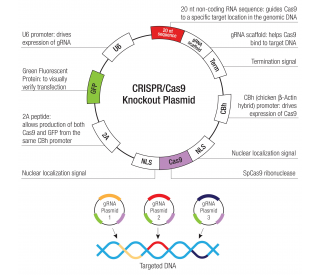Purity
>95%, by SDS-PAGE visualized with Silver Staining and quantitative densitometry by Coomassie® Blue Staining.
Endotoxin Level
<0.10 EU per 1 μg of the protein by the LAL method.
Activity
Measured by its binding ability in a functional ELISA. When Recombinant Human CD155/PVR Fc Chimera is immobilized at 0.5 μg/mL (100 μL/well), the concentration of Recombinant Human DNAM-1/CD226 Fc Chimera (Catalog # 666-DN) that produces 50% of the optimal binding response is approximately 20-120 ng/mL.
Source
Human embryonic kidney cell, HEK293-derived
Human CD155/PVR
(Asp28-Asn343)
Accession # NP_006496IEGRMD Human IgG1
(Pro100-Lys330)N-terminus C-terminus N-terminal Sequence
AnalysisAsp28
Structure / Form
Disulfide-linked homodimer
Predicted Molecular Mass
61 kDa
SDS-PAGE
81-98 kDa, reducing conditions
9174-CD |
| |
Formulation Lyophilized from a 0.2 μm filtered solution in PBS. | ||
Reconstitution Reconstitute at 500 μg/mL in PBS. | ||
Shipping The product is shipped at ambient temperature. Upon receipt, store it immediately at the temperature recommended below. | ||
Stability & Storage: Use a manual defrost freezer and avoid repeated freeze-thaw cycles.
|
Data Images
Bioactivity
| When Recombinant Human CD155/PVR Fc Chimera (Catalog # 9174-CD) is immobilized at 0.5 µg/mL, Recombinant Human DNAM-1/CD226 Fc Chimera (Catalog # 666-DN) binds with a typical ED50 of 20-120 ng/mL. |
Background: CD155/PVR
CD155, also known as PVR (poliovirus receptor), Necl-5 (nectin-like molecule-5) and, in rodents, TAGE4 (tumor-associated glycoprotein E4), is a 70 kDa type I transmembrane glycoprotein in the nectin-related family of adhesion proteins within the immunoglobulin superfamily (1, 2). CD155 binds other molecules including Vitronectin, Nectin-3, DNAM-1/CD226, CD96, and TIGIT but does not bind homotypically (3). Mature human CD155 consists of a 323 amino acid (aa) extracellular domain (ECD) with one N-terminal V-type and two C2-type Ig-like domains, a 24 aa transmembrane segment, and a 50 aa cytoplasmic tail. Within the ECD, human CD155 shares 45% aa sequence identity with mouse and rat CD155, and 52% with human Nectin-2. The V-type domain of CD155 mediates all binding, including to polio virus (1), and alternative splicing within this domain in humans can modulate ligand binding (4). Human CD155 can also be spliced to generate secreted isoforms (5). CD155 is up-regulated on endothelial cells by IFN-gamma and is highly expressed on immature thymocytes, lymph node dendritic cells, and tumor cells of epithelial and neuronal origin (1, 2, 6-9). It is preferentially expressed on Th17 cells compared to Th2 cells (10), and its activation promotes the development of Th1 responses (11). On migrating cells, CD155 is concentrated at the leading edge, where it binds basement membrane Vitronectin, recruits Nectin-3-expressing cells, and cooperates with PDGF and Integrin alpha v beta 3 to promote cell migration (1, 3, 12). Enhanced CD155 expression in tumor cells contributes to loss of contact inhibition and increased migration but also allows tumor cell recognition and killing by DNAM-1 or CD96 expressing NK cells (1, 7, 13). Binding of monocyte DNAM-1 to endothelial cell CD155 promotes transendothelial migration (8). The expression of CD155 on mouse CD8 + thymocytes prevents their premature exit from the thymus (14). Within intestinal Peyer's patches, follicular dendritic cell CD155 activates follicular helper T cells via DNAM-1 or CD96 binding (7-9, 15). CD155 also binds the inhibitory ligand TIGIT on NK and some mature T cells, antagonizing DNAM-1 effects (7, 15, 16).
References:
Mandai, K. et al. (2015) Curr. Top. Dev. Biol. 112:197.
Mendelsohn, C.L. et al. (1989) Cell 56:855.
Sato, T. et al. (2004) Genes to Cells 9:791.
Meyer, D. et al. (2009) J. Biol. Chem. 284:2235.
Koike, S. et al. (1990) EMBO J. 9:3217.
Escalante, N.K. et al. (2011) Arterioscler. Thromb. Vasc. Biol. 31:1177.
Xu, Z. and B. Jin (2010) Cell. Mol. Immunol. 7:11.
Reymond, N. et al. (2004) J. Exp. Med. 199:1331.
Maier, M.K. et al. (2007) Eur. J. Immunol. 37 :2214.
Lozano, E. et al. (2013) J. Immunol. 191:3673.
Yamashita-Kanemaru, Y. et al. (2015) J. Immunol. 194:5644.
Mueller, S. and E. Wimmer (2003) J. Biol. Chem. 278:31251.
Chan, C.J. et al. (2010) J. Immunol. 184:902.
Qui, Q. et al. (2010) J. Immunol. 184:1681.
Seth, S. et al. (2009) Eur. J. Immunol. 39:3160.
Stanietsky, N. et al. (2009) Proc. Natl. Acad. Sci. USA 106:17858.
Long Name:
Poliovirus Receptor
Entrez Gene IDs:
5817 (Human); 52118 (Mouse); 25066 (Rat)
Alternate Names:
CD155 antigen; CD155; HVED; NECL5; Necl-5; nectin-like 5; Nectin-like protein 5; poliovirus receptor; PVR; PVS; PVSFLJ25946; Tage4










